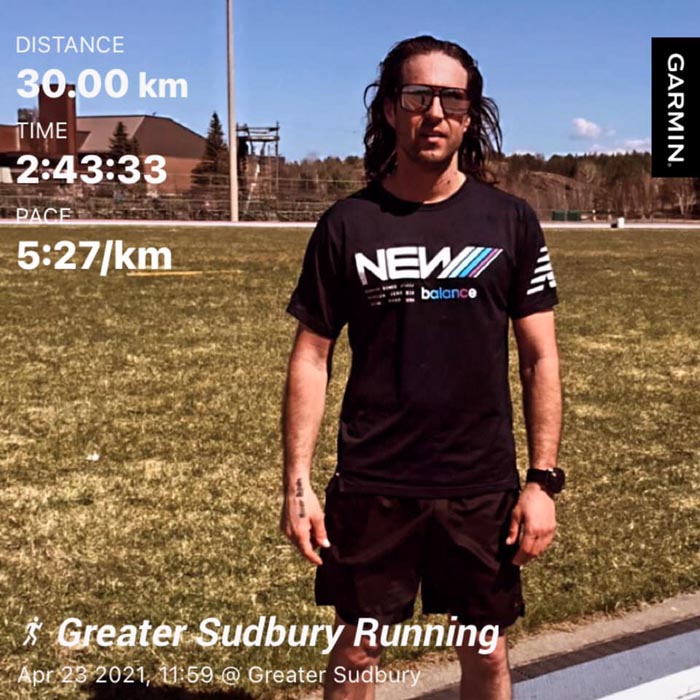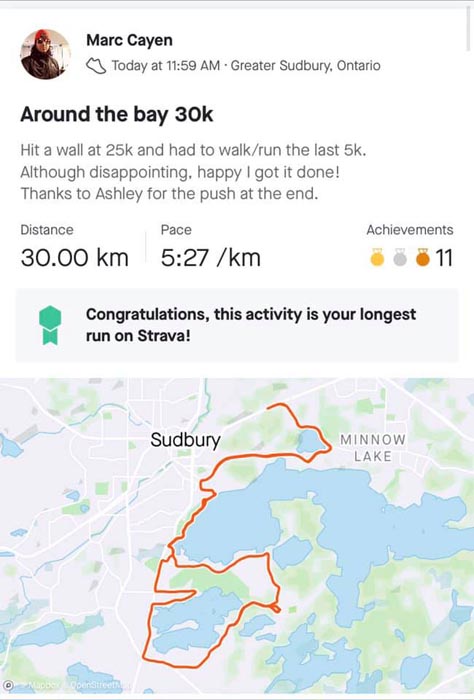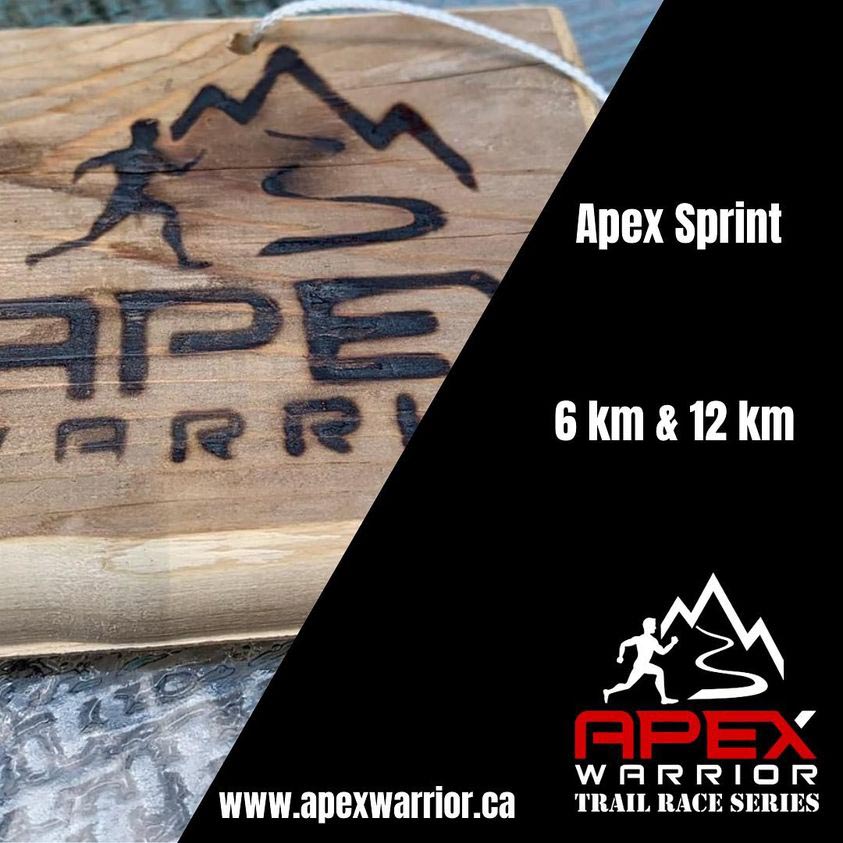Caleb Beland has never run
faster than he has this spring.
Given all of the ups and downs he has
encountered over the course of his time competing for
the Bishop Carter Gators and, Laurentian Voyageurs, as
well as Track North, maybe it’s more surprising
that he is still running at all.
“There was never really
a point where I seriously considered retiring,”
said Beland, now 23 years old and nearing the completion
of his first year of studies at the Canadian Memorial
Chiropractic College in Toronto. “Over the course
of my career, I’ve had far more bad race days than
good, but the good days are so good.
“They are so good that even if it
comes after 30 bad races, the good days make it all worth
it.”
That might not have been the manner in
which Beland described future success when he first eased
his way into the sport as a Grade 9 student at BAC. The
Hanmer-based Catholic secondary school was exactly where
this voyage began, thanks in large part to a mentor with
whom he remains in contact to this day.
“Julie (Denomme) was a fantastic
coach, very supportive,” said Beland. “My
body was rejecting the training; I was actually wearing
knee braces, because my knees were so sore from all of
the running. But Julie was all about the little victories,
reminding me that they would all add up.”
Nine months later, Beland was immersed,
transitioning quickly from a sport of interest to a complete
change of lifestyle. “I qualified for NOSSA in the
3,000 metres in Grade 9, and that was one of the biggest
deciding factors in keeping it going,” he said.
“I was committed, at that point, just from seeing
the gains I had made in year one.
“If I wouldn’t have made NOSSA,
I likely would not have reached out to Track North.”
For the next three years, Beland formed
part of a similar-aged middle-distance quartet under the
leadership of coach Darren Jermyn, a group that included
Brendan Costello, Liam Passi and Tie Pylatuk.
“I got consistently better over
the three years, but the biggest gains, for sure, were
that first year with Track North,” stated Beland.
A 19th-place finish in the senior boys
division of his Grade 10 NOSSA championship provided both
a solid motivational base, but also a set of expectations
which the future kinesiology graduate from Laurentian
University struggled at times to meet.
“Both of my senior years were tough,
mentally and physically,” he recalled. “I
would psyche myself out a lot.”
With his parents on hand for his Grade
11 NOSSA meet, Beland fell short of his goal of qualifying
for provincials — a crushing setback. There was
a reprieve, of sorts, come the outdoor track season in
the spring.
“I did qualify for OFSAA, but I
was running on a broken foot (stress fracture, to be precise),”
he said.
Racing misfortunes would weigh heavy upon
the teen. And for as much as his running mates were his
very best friends, their competitive natures could make
workouts challenging, at times. “I obsessed over
other people’s performance way too much,”
said Beland. “I had so many bad memories from before,
so I had a lot of anxiety going into my final cross-country
season.”
Then, ever so briefly, the light shone
through.
A first-ever SDSSAA gold medal came courtesy
of the steeplechase in Grade 12. An unexpected first-place
finish in the NOSSA 3,000 metres would follow that same
spring.
There was a perspective that could be
maintained.
“I may not have hit the times I
wanted to hit, but I was very happy with my years at Bishop
Carter.”
Off to Laurentian he went, with a whole
new set of goals in mind. Maintain an A average, just
as he had in high school: Check. Qualify for the OUA indoor
track championships: Check. Qualify, as a team, for the
national cross-country championships: Check.
Still, there was the ebb and flow.
“I really underperformed in my first
year,” said Beland. “I really underestimated
the workload involved. Mentally, it was much tougher in
a university setting. I had expectations of myself and
didn’t come close to achieving them, so I was pretty
down on myself.”
Perseverance, however, is a wonderful
thing. Combined with a strong support system both on campus
and off, Beland clung to the nuggets of improvement.
“I actually made some really big
gains between both first and second year, and between
second and third year,” he said.
And for as much as his fourth and final
year at LU was memorable in many a good way, it was certainly
not linear, nothing in the form of success built upon
success.
“None of my cross-country races
that fall were great, but thankfully I ended my career
with a really good performance at nationals,” he
noted.
The indoor season, as he termed it, almost
became a victory lap, an added bonus given his results
at U Sports cross-country.
“I PB’d my 1,500 early in
the season, but then had some really rough races.”
His worst ever “blowout,”
as he referenced it, came at an indoor meet in Boston.
Still, as his local studies came to an end, Beland was
not about to hang up his cleats.
“I wanted to continue to train,
even after Laurentian,” he said. “Many of
the greatest moments of my life are attributable to this
sport. It’s such a huge part of my identity. I plan
to keep going until I can’t.”
There was little doubt that the concept
of road racing clearly appealed to the longtime runner.
But one could understand if, at some point
in time, the emotional roller-coaster simply becomes too
much to handle. As we speak, Caleb Beland is almost exactly
one year post his graduation from LU — but what
a year it has been, even as he balances his training with
the demands of chiropractic college.
“It’s been a year now where
I’ve been at a completely different level than I
have ever been,” he acknowledged. Minutes are being
shed like nobody’s business. A time of 31:15 in
the 10 kilometres last June; a fall 5K run in 14:34; an
8K time trial, coming off tempo and hills workouts, with
a clocking of 24:40.
Sure, these are all unofficial, but more
than a little encouraging.
“It’s kind of bizarre, because
I can’t remember a distinct point where it changed.”
Beland would be the first to suggest that
there is no coach in his midst, no supportive friend,
teammate or family member who has ever placed undue pressure
upon him — which is not to say that he can avoid
putting the pressure on himself.
“I’ve always felt an obligation
to perform and give my best,” he said. “I
feel that I’ve always tried my best, but it wasn’t
always my best performance.”
Maybe therein lies the secret to this
latest chapter, running free from the ties of being part
of a team. Beland is the first to admit that he does not
hold all of the answers. This current stretch is what
it is (cue fingernails screeching across a blackboard!).
“I’m so much more relaxed
now,” he said.
That being the case, as many a coach might
suggest, just go with it, young man — and see where
the process might lead you.
Randy Pascal’s That Sudbury Sports
Guy column runs regularly in The Sudbury Star.
|










219.jpg)































